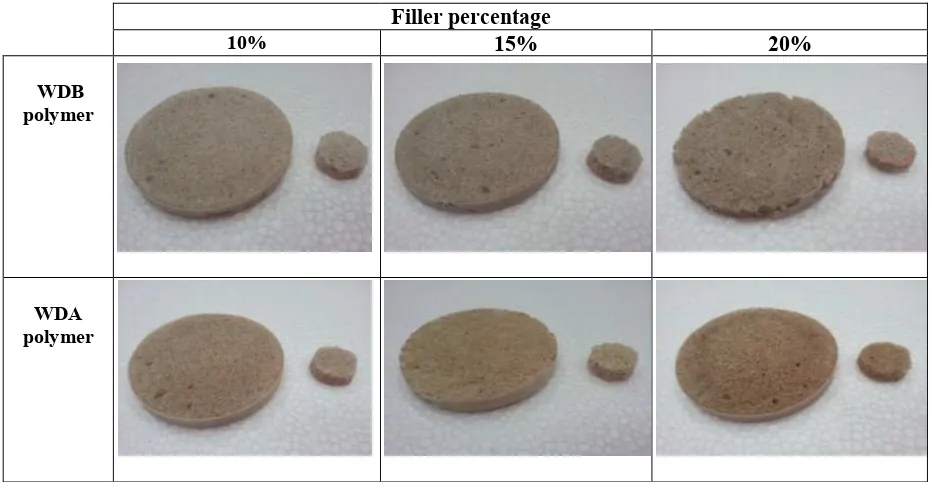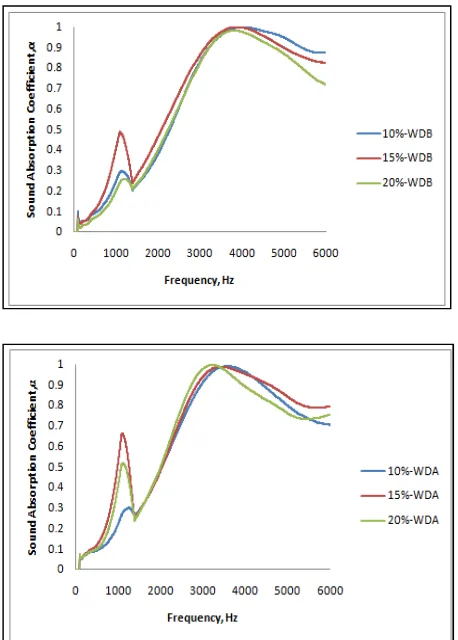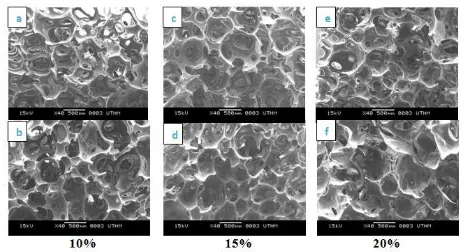Utilization of treated Red Meranti wood dust as polymer foam composite
for acoustic study
Shafizah Sa’adon.
1, a, Anika Zafiah M. Rus
1, b, *1,2
Sustainable Polymer Engineering
Advanced Manufacturing and Material Center (AMMC) Faculty of Mechanical and Manufacturing Engineering
Universiti Tun Hussein Onn Malaysia, Johor 86400, Parit Raja, Batu Pahat, Johor, MALAYSIA
a
shafizahsaadon@rocketmail.com, *bzafiah@uthm.edu.my
Keywords: sound absorption, Red Meranti Wood Dust, polymer composite, porous
Abstract A Red Meranti Wood Dust (RMD) act as a filler for polymer foam composite has been investigated and proved to have ability to absorb sound. In this study, treatment of wood dust with and without acid hydrolysis named as WDB and WDA respectively was use as filler. This study was developed to compare the ability of sound absorption based on treated filler and particle size of wood dust. By choosing the size of 355 µm, three different percentage has been selected which is 10%, 15% and 20% for both conditions. These samples has been tested by using Impedance Tube test according to ASTM E-1050 for sound absorption coefficient, α measurement and Scanning Electron Microscopy (SEM) for determine the porosity for each samples. 10% loaded of WDB as filler gives highest sound absorption coefficient of 0.999 at 4015.63 Hz. Meanwhile for 20% loaded of WDA gives 0.997 at 3228.13 Hz. When comparing the sound absorption coefficient for both sounds absorbing materials, WDB-polymer foam composite RMD showed higher value of sound absorption coefficient, α at higher frequency as compared to WDA-polymer foam composite.
Introduction
As the problem of hazardous noise has become serious, the demand of better environment and residential safety is increased and becomes a major requirement. From previous study, polyurethane foams composites made from palm oil were synthesized, crosslink and doped with eco natural filler of rubber waste or sawdust powder [1-2]. As natural resources become scarce, many researchers and industries are beginning to investigate and utilize various renewable resources such as the abundant and cheap vegetable oils, which represent a major potential source of chemicals [3-4].
In the recent years, a number of studies have been carried to develop new materials and technologies improving the sound absorption properties [5-6]. The sound of an industrial waste developed by using processed bamboo and oil palm frond has been tested for its sound absorption properties [7-8]. Sound absorbing materials absorb most of the sound energy striking them and reflect very little. Therefore, sound-absorbing materials have been found to be very useful for the control of noise [9]. Materials that have high value of sound absorption coefficient are usually porous [10]. The absorption coefficient is a useful concept when using geometrical acoustic theory to evaluate the growth and decay of sound energy in a room [11].
Impedance tube measurement of the bamboo, fiber samples reveal similar properties to the glass wool. Bamboo material formed into fiber board yield a superior sound absorption as compared to plywood material of similar density [7].
In this present study, a comparison between before and after acid hydrolysis treatment of RMD contributed as filler to composite foam to measure the sound absorption ability and understanding the quality of fibrous material in composite foam.
Methodology
Determination of acoustic by impedance tube test
The impedance tube consists of a adjustable filter, propagation tube, large sample tube 100 mm diameter, small sample tube 28 mm diameter and two-microphone method and a digital frequency analysis system for the measurement of normal incidence sound absorption coefficient and normal specific acoustic impedance ratios of materials.
Preparation of samples
Wood dust with 355 µm in size, untreated and treated with acid hydrolysis named as WDB and WDA with percentage of 10%, 15% and 20% respectively were used as filler in polymer foam composites. The pore size and structures of composites during the cross linking with polyol and isocyanate was also monitored. Specific designed of close mold with 100 mm diameter and 28 mm diameter was used to fabricate the samples. Table 1 shows the RMD-polymer composite before and after acid treatment of the filler.
Table 1: Polymer foam composite samples with different percentage of wood dust filler. Each sample size consists of 100 mm and 28 mm in diameter.
Result and Discussion
All samples with different percentages of polyurethane have been tested for sound absorption coefficient. Fig. 1 and 2 shows the sound absorption coefficient at different frequency level of all samples treated and untreated with 10%, 15% and 20% of WD filler. In general, both treated of sample demonstrated higher absorption coefficients for medium to high frequency range of 3000 - 5000 Hz. This wider range of frequencies highlights the potential of WD polymer foam composites for sound absorbent material. However, WDB polymer foam composites with all percents of filler demonstrate better performance to its counterpart, which most samples gives maximum absorption coefficient at higher frequency level of 3500- 4200 Hz. Meanwhile, the highest sound absorption coefficient for WDA polymer composites loaded with 10%, 15% and 20% RMD at high frequency level of 3000 – 4000 Hz.
Filler percentage
10% 15% 20%
WDB polymer
[image:2.595.65.531.370.611.2]For Fig.1, graph for 10% filler-loading-polymer foam composites shows high sound absorption coefficient, α at highest frequency as compared to the other percentage of filler. The maximum α for WDB is 10% and 15% loaded with RMD of 0.999 at 4015 Hz, as for Fig. 2 the maximum α for WDA is 20% loaded with RMD of 0.997 at 3228 Hz. It may be due to the changes of WD structure after acid treatment which affects the size of porosity as refer to Fig.3 resultants in higher sound absorption coefficient at lower frequency level. Fig. 3 also shows the porosity structure of WDB and WDA. Acid treatments of RMD influence the pores structure of RMD polymer foam composites. In Fig. 3 (f), the RMD was loaded with highest WDA of 20% gives bigger pore size of the foam, whereby the large size of porous cell increases the absorption coefficient at low frequency level [13].The physical condition of WDA polymer foam composites is slightly brittle as compared to WDB polymer foam composite.
Figure 1. Absorption coefficient (α) of WDB polymer foam composite of 10%, 15% and 20% filler loading
[image:3.595.57.286.255.575.2]Figure 3. SEM images of WDB and WDA of polymer foam composite which consist of different percentage of filler loading a, c, and e is WDB-polymer foam composite, while b, d, and f is WDA-polymer foam composite.
Conclusions
The Red Meranti-WDB polymer foam composite samples show the ability to influence the absorption coefficient of polymeric foam at different frequency levels. 10% and 15% of WDB polymer foam composite was achieved the highest sound absorption coefficient value α of 0.999 at 4015 while 20% filler of WDB was able to absorb the sound at the highest frequency level of 0.973 at 4775 Hz. This kind of polymer composite can be applied for cushion, sound-proof wall or building structure. Red Meranti wood dust can be used as a sound absorption material and the effectiveness of samples was determined by the condition and the percentage filler added and the porosity if the samples itself. The two condition of the wood dust which is before and after acid treatment gives different result in sound absorption coefficient at different frequency level.
Acknowledgment
The author would to thank the supervisor and all who have contributed in making this research a success. The author would like to thanks Universiti Tun Hussein Onn Malaysia (UTHM), Johor and Malaysian Government for supporting this research under Malaysian Technical University Center of Excellent (MTUN-COE) vot C018.
References
[1] M.R Anika Zafiah: Polymer from Renewable Materials, Science Progress, Vol.93 (2010), Iss.3, p.285-300
[2] M.R. Anika Zafiah,: Degradation Studies of Polyurethanes Based on Vegetable Oils. Part2; Thermal Degradation and Materials Properties, Prog React Kinetic and Mechanism, Science Reviews, Vol.34 (2009b), p.1-43
[4] M.R Anika Zafiah: Effect of Titanium Dioxide on Material Properties for Renewable Rapeseed and Sunflower Polyurethane, International Journal of Integrated Engineering (Issues on Mechanical, Materials and Manufacturing Engineering),Vol.1 (2009a), p.15-22
[5] J.Zhang , S.L. Zhao, Y.Guo: Repolypropylene block burn foam absorption sound on research, Noise Libration Control, Vol. 3 (1997), p.36–39
[6] B.Z. Yu: New hot isolation and sound absorption damp material–porous polymer. New Architect Mater, 3(4), p.9–12 (1999).
[7] T.Koizumi, N. Tsujiuchi, and A. Adachi: The development of sound absorbing materials using natural bamboo fibers, In: Brebbia, C.A. and Wilde DE W.P (eds). High performance Structures and Composites: The Built Environment (2002), p. 157-66. Witpress.com
[8] T. Sihabut: Noise control efficiency of fiber board made from oil palm frond. M.Sc. Thesis, Mahidol University. (1999)
[9] J.P. Arenas and M.J. Crocker: Recent Trends in Porous Sound-Absorbing Materials. Sound & Vibration. (2010)
[10] M.J. Crocker and J.P. Arenas: use of sound-absorbing materials, Chapter 57 in Handbook of Noise and Vibration Control (M.J. Crocker, Ed.), John Wiley and Sons, New York. (2007)
[11] M.R. Anika Zafiah, M.H. Nik Normunira, and S. Nurulsaidatulsyida: Influence of biopolymer doped with ecofiller as a sound absorption materials. Global & technologist reviews. Vol.2 (2012), No.4
[12] J.C. Parajó, H.Dominguez , J.M. Dominguez: Biotechnological production of xylitol. Part3. Operation in culture media made from lignocelluloses hydrolysate. Bioresources
Technol. Vol. 66 (1998), p. 25-40.


